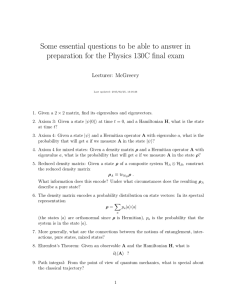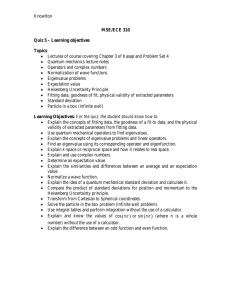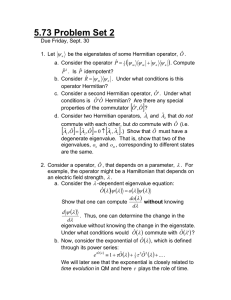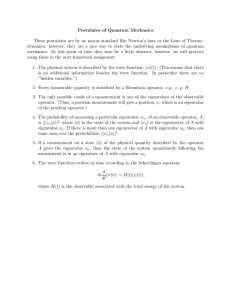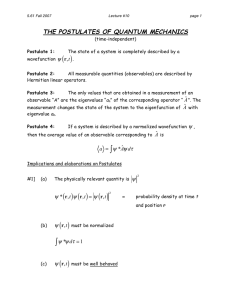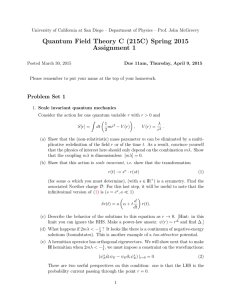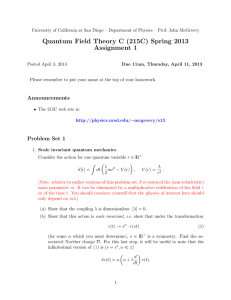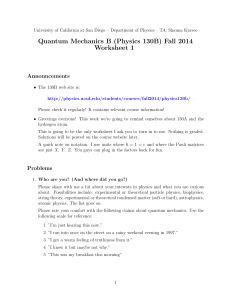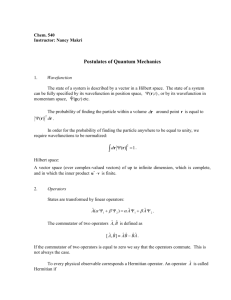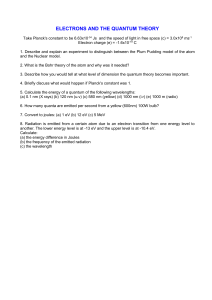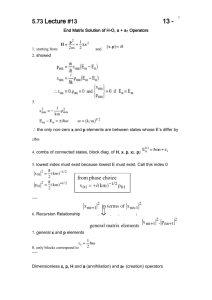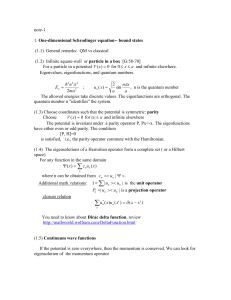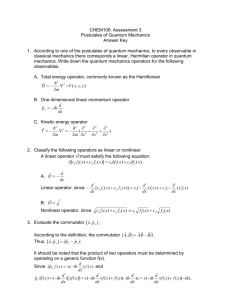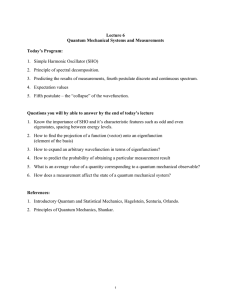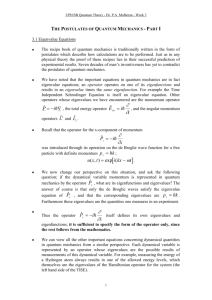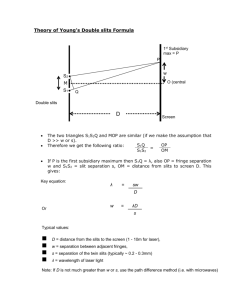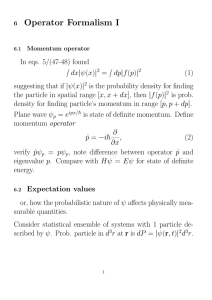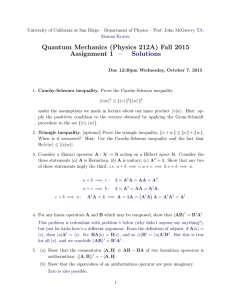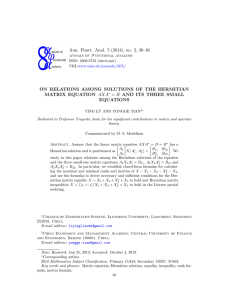Chapter Test
advertisement
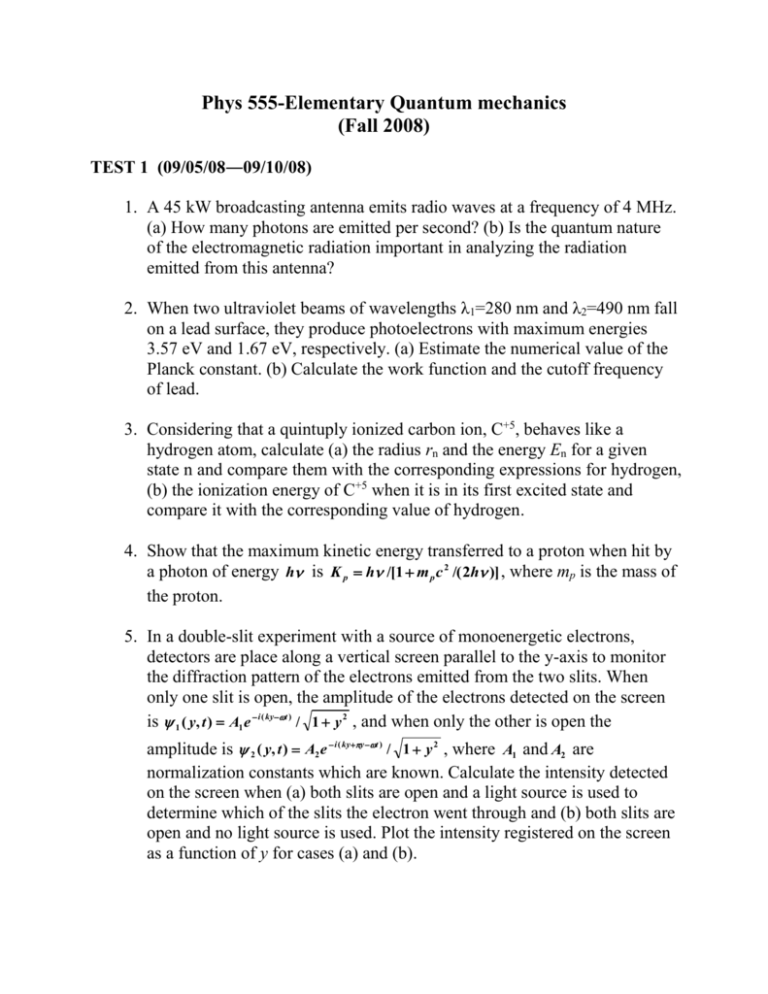
Phys 555-Elementary Quantum mechanics (Fall 2008) TEST 1 (09/05/08―09/10/08) 1. A 45 kW broadcasting antenna emits radio waves at a frequency of 4 MHz. (a) How many photons are emitted per second? (b) Is the quantum nature of the electromagnetic radiation important in analyzing the radiation emitted from this antenna? 2. When two ultraviolet beams of wavelengths λ1=280 nm and λ2=490 nm fall on a lead surface, they produce photoelectrons with maximum energies 3.57 eV and 1.67 eV, respectively. (a) Estimate the numerical value of the Planck constant. (b) Calculate the work function and the cutoff frequency of lead. 3. Considering that a quintuply ionized carbon ion, C+5, behaves like a hydrogen atom, calculate (a) the radius rn and the energy En for a given state n and compare them with the corresponding expressions for hydrogen, (b) the ionization energy of C+5 when it is in its first excited state and compare it with the corresponding value of hydrogen. 4. Show that the maximum kinetic energy transferred to a proton when hit by a photon of energy h is K p h /[1 m p c 2 /( 2h )] , where mp is the mass of the proton. 5. In a double-slit experiment with a source of monoenergetic electrons, detectors are place along a vertical screen parallel to the y-axis to monitor the diffraction pattern of the electrons emitted from the two slits. When only one slit is open, the amplitude of the electrons detected on the screen is 1 ( y, t ) A1 e i ( kyt ) / 1 y 2 , and when only the other is open the amplitude is 2 ( y, t ) A2 e i ( kyy t ) / 1 y 2 , where A1 and A2 are normalization constants which are known. Calculate the intensity detected on the screen when (a) both slits are open and a light source is used to determine which of the slits the electron went through and (b) both slits are open and no light source is used. Plot the intensity registered on the screen as a function of y for cases (a) and (b). Chapter Test of Phys 555-Elementary Quantum mechanics (Fall 2008) TEST 2 (09/22/08―09/26/08) 1. Consider the Gaussian distribution: ( x ) Ae ( x a ) , where A, a and λ are positive 2 real constants. (a) Use equation 1 ( x)dx to determine A. (b) Find x , x 2 , and σ. (c) Sketch the graph of ( x ) . (Hint: e u du 2 .) d p d p V 2. Use p i and prove that . In dx to calculate dt x dt x d x d p V fact, equations p m ) and are instances of Ehrefest’s dt dt x theorem, which tells us that expectation values obey classical laws. 3. A particle of mass m is in the state ( x, t ) Ae amx / it , where A and a are positive real constants. (a) Find A. (b) For what potential energy function V(x) does Ψ satisfy the Schrödinger equation? (c) Calculate the expectation values of x, x2, p, and p2. (d) Find σx and σp. Is their product consistent with the uncertainty principle? 2 d 1 2 dx 0 for any two (normalizable) solutions to the Schrödinger dt equation, Ψ1 and Ψ2. 4. Show that 5. Let Pab(t) be the probability of finding a particle in the range ( a< x < b), at time t. (a) dPab i . What are Show that J ( a, t ) J ( b, t ) , where J ( x, t ) 2m x x dt the units of J(x,t)? Comment: J is called the probability current, because it tells us the rate at which probability is “flowing” past the point x. If Pab(t) is increasing, then more probability is flowing into the region at one end than flows out at the other. (b) Find the 2 probability current for the wave function ( x, t ) Ae amx / it . Chapter Test of Phys 555-Elementary Quantum mechanics (Fall 2008) TEST 4 (11/14/08―11/21/08) 1. (a) Suppose that f(x) and g(x) are two eigenfunctions of an operator Q̂ , with the same eigenvalue q. Show that any linear combination of f and g is itself an eigenfunction of Q̂ , with eigenvalue q. (b) Check that f(x)=exp(x) and g(x)=exp(-x) are eigenfunctions of the operator d 2 / dx 2 , with the same eigenvalue. Construct two linear combinations of f and g that are orthogonal eigenfunctions on the interval (-1,1). 2. An anti-hermitian operator is equal to minus its hermitian conjugate: Q̂ †= Q̂ . (a) Show that the expectation value of an anti-hermitian operator is imaginary. (b) Show that the commutator of two hermitian operators is anti-hermitian. How about the commutator of two anti-hermitian operators? 3. Consider a three-dimensional vector space spanned by an orthonormal basis 1 , 2 , 3 . Kets and are given by i 1 2 2 i 3 , i 1 2 3 . (a) Construct and in terms of the dual basis 1 , 2 , 3 . (b) Find and , and confirm that . (c) Find all nine matrix elements of the operator A , in this basis, and construct the matrix A. Is it hermitian? 4. he Hamiltonian for a certain three-level system is represented by the matrix 1 0 0 H 0 2 0 . (a) Find the eigenvalues and (normalized) eigenvectors of H. (b) 0 0 2 c1 Suppose the system starts out in the generic state ( 0) c 2 , where c 3 2 2 c1 c 2 c 3 2 1 . Find the expectation values of H. (c) What is (t ) ? If you measured the energy of this state (at t=0), what values might you get, and what is the probability of each?
